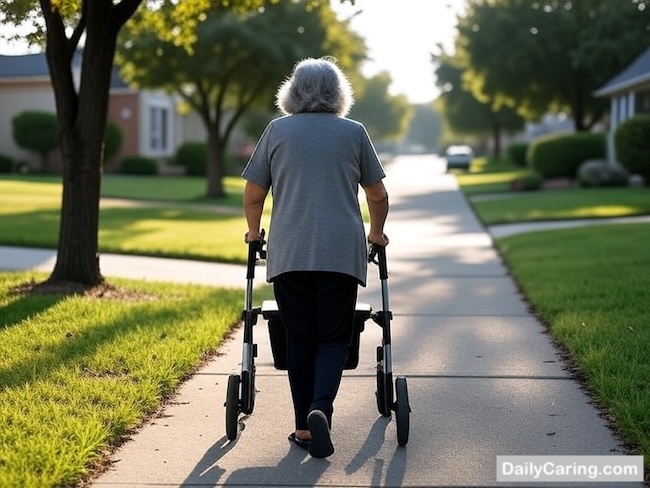The good news? With the proper support, a walker can become a fantastic tool for improving balance and confidence; however, it’s essential to take steps to enhance strength and flexibility for older adults.

Here are five gentle (physical therapist-approved) exercises explicitly designed for walker users to build stability and independence, all while staying safely supported.
Balance Exercises for Seniors Can Prevent Falls
Exercise helps older adults maintain their strength and independence by improving their physical strength and balance.
We found a free 5-minute video featuring physical therapists demonstrating five simple, safe, and effective at-home balance exercises for seniors who use a walker.
When performed regularly, these exercises significantly improve strength, increase balance and stability, and reduce the risk of falls.
We explain why seniors who use a walker still need to improve balance, how to stay safe while exercising, and share a step-by-step guide to these five exercises.
Older Adults Who Use Walkers Need Balance Exercises to Prevent Falls
Seniors who use a walker receive some balance support, but this doesn’t mean they are no longer vulnerable to falls.
Data showed that every day, 129 American seniors were treated in emergency rooms for injuries caused by a fall while using a walker or a cane.
This could be because seniors haven’t been fitted for or trained to use their mobility aid adequately.
But it’s also because they’re already at increased fall risk, which is why they need a mobility aid in the first place.
That’s why older adults need to exercise regularly to enhance their balance and stability.
By using a properly secured walker, seniors can get the support they need to stay safe during exercise.
Safety First! Prevent Falls While Exercising
The last thing anyone wants is for someone to fall or be injured while exercising.
For support and safety, stand close and be ready to support your older adult – be extra cautious the first few times they try these exercises.
Keep a sturdy chair nearby and have them sit and take breaks when they get tired. Let them know they should avoid any exercise that causes pain.
If your older adult is especially frail or unsteady, consider using an inexpensive gait belt for added safety and stability.
Encourage them to continue the exercises with you by their side – they will gain strength over time.
A Helpful Guide to Five Balance Exercises for Seniors
For all of these balance exercises, an older adult should stand at their walker, holding the handles.
If the walker has brakes, make sure they’re engaged. Ask your older adult not to lean on or place too much weight on the walker, as this could cause it to slide.
If you’re concerned the walker could roll forward, position it against a wall, a couch, or another sturdy barrier to prevent movement.
Additionally, place a sturdy, non-slip chair directly behind your older adult in case they become tired or lose their balance and need to sit down suddenly (as seen in the video at 1 min 10 sec).
Exercise 1 (1:22 in video)
March in place, lifting knees as high as possible. Do 10 on each leg for a total of 20 marching steps,
Exercise 2 (1:49 in video)
Lift one leg out to the side using a slow, controlled motion. Do 10 lifts on each leg, one side at a time.
To get the full benefit of the exercise, have your older adult move slowly and watch out for signs of “cheating” (1:59 in video).
VIDEO: The Top Five Exercises You Can Do With a Walker
Exercise 3 (2:24 in video)
Lift one leg straight back behind the body. Do 10 lifts on each leg, one leg at a time.
Watch out for signs of “cheating” (2:38 in video).
Exercise 4 (2:55 in video)
Stand with your feet about shoulder-width apart. Slowly do a slight squat, being careful not to bend too low, especially at first. Do 10 squats.
As lower body strength builds over time and this exercise gets easier, slowly increase the depth of the squat.
Exercise 5 (3:35 in video)
While standing, lift your heels to stand on your toes. Then, lower your heels to return your feet to a flat position.
Next, lift toes and slowly rock back on heels. Ensure their walker is secured before they pull it on, or they could slide and fall.
Repeat 10 times.
Practice is More Important Than Perfection
Even if your loved one can’t do the exercises perfectly or can only manage 10 repetitions, continue to encourage them to do their best and exercise regularly.
As your older adult gains strength and balance over time, they’ll be able to do more and more.
Recommended for you:
- Chair Yoga for Seniors: Reduce Pain and Improve Health
- 12 Easy and Gentle Seated Stretching Exercises for Seniors in 4 Minutes
- 10 Minute Easy and Effective Chair Exercises for Seniors
This article contains affiliate links. We never link to products or services for the sole purpose of making a commission. For more information, see How We Make Money.
About the Author

Connie is the founder of DailyCaring.com and was a hands-on caregiver for her grandmother for 20 years. (Grandma made it to 101 years old!) She knows how challenging, overwhelming, and all-consuming caring for an older adult can be. She also understands the importance of support, especially in the form of practical solutions, valuable resources, and self-care tips.













Exercises for older people. (Male 94). I’m deaf. Is there any audio that will prevent me from understanding the exercises correctly? Thank you for your attention.
Unfortunately since we’re not medical professionals, we can’t give advice on what will or won’t be safe for specific people. It would be best to review this with a healthcare professional to find out if these exercises are safe and appropriate for your physical abilities and current health conditions.